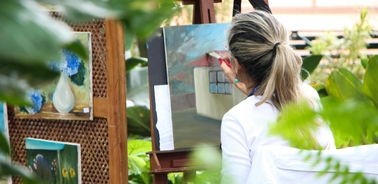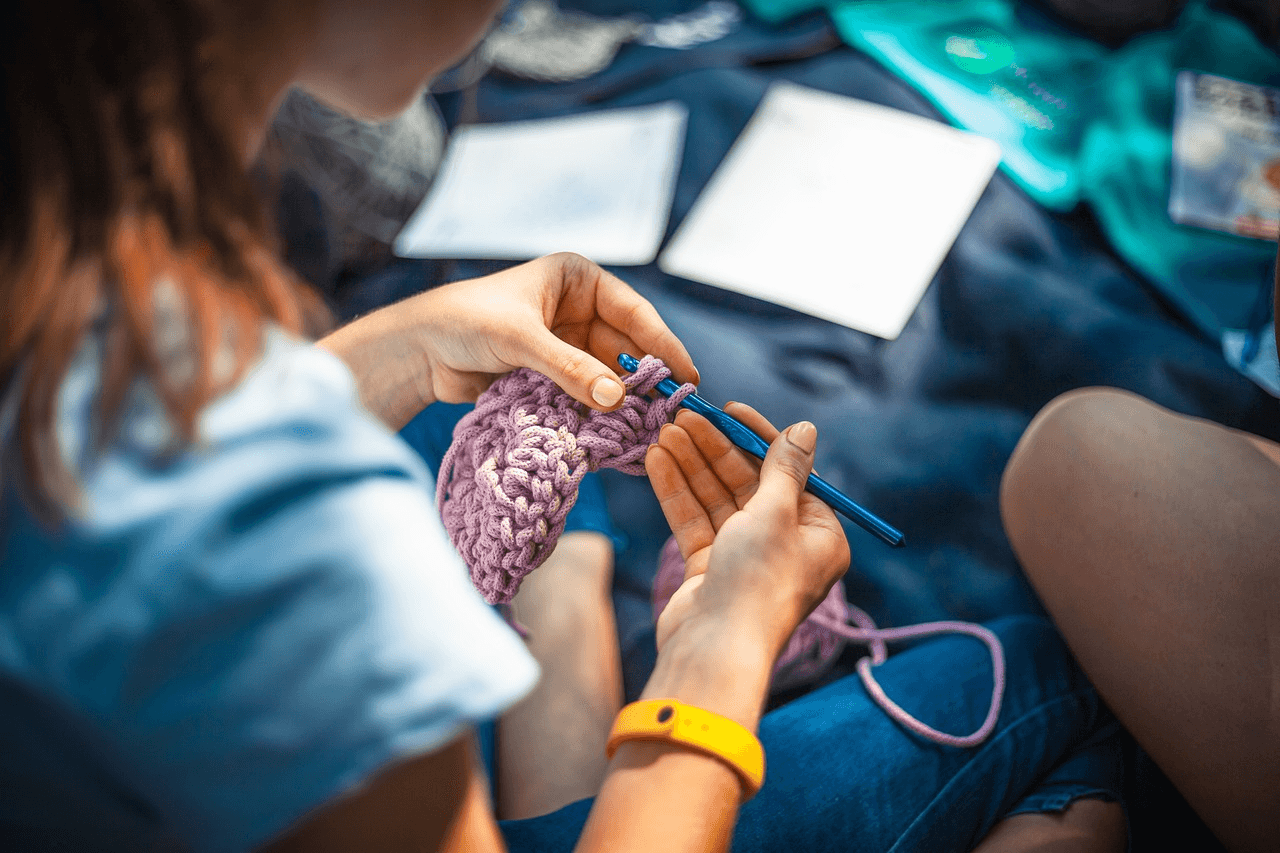Unlocking Your Inner Artist: How Creative Hobbies Can Help You Destress

The science of self-expression and creative outlets for mental restoration
In the age of hyperconnectivity and digital demands, many professionals and students alike are looking for effective ways to decompress. While wellness trends often focus on mindfulness or physical fitness, one profoundly underutilized path to mental restoration lies in creative hobbies.
Whether it's sketching in a notebook, crafting poetry or playing an instrument, creative engagement offers a scientifically supported route to lower stress and enhance overall well-being.
Creativity as a tool for self-regulation
Engaging in creative activities does more than simply provide a break from routine, it helps recalibrate the nervous system. Emerging research suggests that engaging in relaxing activities, including creative pursuits, can activate the parasympathetic nervous system. This engages the body's natural "rest and digest" response, which counters stress and lowers heart rate and blood pressure. A systematic review of research on art therapy demonstrated that creative activities are very effective for stress relief (Martin et al., 2018). Even short, unstructured bursts of creativity can help lower cortisol levels, the hormone responsible for stress.
Importantly, this isn't limited to traditionally "artistic" people. Creativity is a fundamental human trait, not a specialized talent. Dr Daisy Fancourt at University College London led the BBC Arts Great British Creativity Test, which found that creative activities help regulate emotions through mechanisms such as distraction, contemplation and self-development (Fancourt & Steptoe, 2019). The study involved nearly 50,000 participants and demonstrated cumulative benefits from regular engagement in creative activities. These activities were shown to improve emotional regulation, boost self-esteem and provide coping strategies during hardships.
Bridging creativity and professional performance
Creativity doesn't just soothe the mind; it sharpens it. In a 2021 Forbes article, Bianca Barratt highlights creativity expert Jessica Hughes' insights on how embracing one's inner artist can relieve stress and enhance business acumen. Hughes explains, “I have relied heavily on art as a daily tool for my own mental hygiene … to handle the stressors of life from a much firmer foundation and an open, curious mindset.”
By allowing the subconscious mind more freedom, these activities improve self-awareness, reduce stress and cultivate adaptability, ultimately empowering leaders and professionals to think more flexibly and perform effectively under pressure.
Engaging in creative activities can also enhance cognitive flexibility and problem-solving skills. Carmine Gallo suggests that creative pursuits can improve adaptability and confidence in professional settings. For instance, changing environments and introducing diverse perspectives are known to magnify creativity and innovation in the workplace (Gallo, 2012).
This idea is supported by Dr Kevin Eschleman’s research at San Francisco State University, which found that employees who engage in creative hobbies outside of work report greater job satisfaction, improved collaboration and enhanced creativity in their professional roles (Eschleman et al., 2014). These activities also help individuals recover from work-related stress and build psychological resilience by offering experiences of mastery and control.
The science behind the stress relief
Why does making art feel good? From a neurological standpoint, creative expression engages multiple areas of the brain simultaneously, regions responsible for emotion regulation, sensory integration and executive functioning. This multi-system activation leads to what psychologists term a “flow state,” where time seems to melt away and individuals experience deep immersion and enjoyment.
In a 2016 study by Kaimal, et al., participants who engaged in 45 minutes of art-making experienced significantly lower cortisol levels post-session, regardless of skill level. The key factor was not the aesthetic quality of the art, but the act of expression itself.
This therapeutic effect isn’t restricted to visual arts. A 2024 review of randomized controlled trials found that music therapy is increasingly recognized as an effective intervention for managing anxiety, reducing PTSD symptoms and supporting recovery from mental illness (Ma et al.). Previous research, including a 2020 systematic review, shows that music therapy can significantly lower physiological markers of stress, such as heart rate and respiratory rate, while also improving emotional regulation and psychological resilience (de Witte, et al.). Even recreational engagement with music has demonstrated benefits in reducing stress and enhancing overall well-being.
Reclaiming creativity in a goal-oriented world
One barrier to entry for many adults is the perception that creative expression must yield something “good.” This mindset, shaped by academic grading systems and performance-driven cultures, can inhibit experimentation. But the health benefits of creativity have nothing to do with mastery. The value lies in the process.
Once you give yourself permission to create without the expectation of perfection, you open the door to access deeper levels of self-discovery and personal insight. Carolyn Mehlomakulu, a therapist specializing in art-inspired techniques, explains that engaging in creative activities such as doodling or freewriting helps uncover emotions, values and strengths while reducing perfectionism (2018). These practices serve as powerful tools for self-care and emotional regulation.
Here at the IE Center for Health and Well-being, we recognize that incorporating creative hobbies into daily life can be a powerful tool for stress management. As research has shown, it’s a scientifically valid path toward better performance, emotional resilience and overall well-being. Creativity is not a diversion from learning or work, it’s a necessary part of excelling in both.
Don’t miss the creativity practice designed by Baruc Corazon. It’s all about exploring self-expression through simple, mindful exercises that spark imagination and joy, reminding us that creativity isn’t just for artists, it’s for everyone.
References
Barratt, B. (2021, June 3). How embracing your inner artist can relieve stress and make you better at business. Forbes. https://www.forbes.com/sites/biancabarratt/2021/06/03/how-embracing-your-inner-artist-can-relieve-stress-and-make-you-better-at-business/
Bupa. (2023, January 26). How do creative hobbies benefit your health? Bupa Newsroom. https://www.bupa.co.uk/newsroom/ourviews/creativity-hobbies-benefit-health
Carr, C., d'Ardenne, C., Sloan, A., Shropshire, M., Hogg, P., & Unterrassner, L. (2021). Creative arts interventions for stress management and resilience in healthcare professionals: A systematic review. European Journal of Trauma & Dissociation, 5(1), 100166. https://www.tandfonline.com/doi/full/10.1080/17437199.2020.1846580
De Witte, M., Da Silva Pinho, A., Stams, G., Moonen, X., Bos, A. E., & Van Hooren, S. (2020). Music therapy for stress reduction: a systematic review and meta-analysis. Health Psychology Review, 16(1), 134–159. https://doi.org/10.1080/17437199.2020.1846580
Eschleman, K. J., Madsen, J., Alarcon, G., & Barelka, A. (2014). Benefiting from creative activity: The positive relationships between creative activity, recovery experiences and performance-related outcomes. Journal of Occupational and Organizational Psychology, 87(3), 579–598. https://doi.org/10.1111/joop.12064
Fancourt, D., & Steptoe, A. (2019, May 8). Creative activities help the brain to cope with emotions. UCL News. https://www.ucl.ac.uk/news/2019/may/creative-activities-help-brain-cope-emotions
Gallo, C. (2012, September 19). 3 traps to kill your team's creativity. Forbes. https://www.forbes.com/sites/carminegallo/2012/09/19/3-traps-to-kill-your-teams-creativity/
Goldman, M. (2024). Efficacy and acceptability of music therapy for post-traumatic stress disorder: A systematic review and meta-analysis of randomized controlled trials. Annals of the New York Academy of Sciences, 1534(1), 61–83. https://pmc.ncbi.nlm.nih.gov/articles/PMC11036901/
Kaimal, G., Ray, K., & Muniz, J. (2016). Reduction of cortisol levels and participants' responses following art making. Art Therapy, 33(2), 74-80. https://doi.org/10.1080/07421656.2016.1166832
Ma, Y., Yuan, M., & Zhong, B. (2024). Efficacy and acceptability of music therapy for post-traumatic stress disorder: a systematic review and meta-analysis of randomized controlled trials. European Journal of Psychotraumatology, 15(1). https://doi.org/10.1080/20008066.2024.2342739
Martin, L., Oepen, R., Bauer, K., Nottensteiner, A., Mergheim, K., Gruber, H., & Koch, S. C. (2018). Creative Arts Interventions for Stress Management and Prevention—A Systematic Review. Behavioral Sciences, 8(2), 28. https://doi.org/10.3390/bs8020028
Mehlomakulu, C. (2018). 8 art-inspired techniques to spark self-discovery. Psych Central. https://psychcentral.com/blog/8-art-inspired-techniques-to-spark-self-discovery#1
